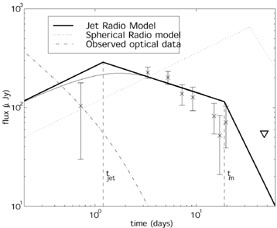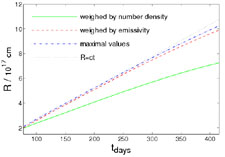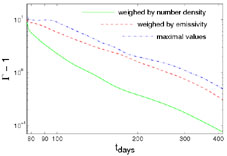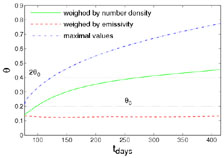


H. Generalizations: IV. Jets
The afterglow theory becomes much more
complicated if the relativistic ejecta is not spherical. The
commonly called "jets" corresponds to relativistic matter ejected
into a cone of opening angle
 . I stress that unlike other
astrophysical jets this ejecta is non steady state and generally
its width (in the direction parallel to the motion) is orders of
magnitude smaller than the radius where the jet is. A "flying
pancake" is a better description for these jets.
. I stress that unlike other
astrophysical jets this ejecta is non steady state and generally
its width (in the direction parallel to the motion) is orders of
magnitude smaller than the radius where the jet is. A "flying
pancake" is a better description for these jets.
The simplest implication of a jet geometry, that exists regardless
of the hydrodynamic evolution, is that once
 ~
~
 -1
relativistic beaming of light will become less
effective. The radiation was initially beamed locally into a cone
with an opening angle
-1
relativistic beaming of light will become less
effective. The radiation was initially beamed locally into a cone
with an opening angle
 -1
remained inside the cone of the original jet. Now with
-1
remained inside the cone of the original jet. Now with
 -1 >
-1 >
 the emission is
radiated outside of the initial jet. This has two effects: (i) An
"on axis" observer, one that sees the original jet, will detect a
jet break due to the faster spreading of the emitted radiation.
(ii) An "off axis" observer, that could not detect the original
emission will be able to see now an "orphan afterglow", an
afterglow without a preceding GRB (see
Section VIIK). The
time of this transition is always give by Eq. 104 below
with C2 = 1.
the emission is
radiated outside of the initial jet. This has two effects: (i) An
"on axis" observer, one that sees the original jet, will detect a
jet break due to the faster spreading of the emitted radiation.
(ii) An "off axis" observer, that could not detect the original
emission will be able to see now an "orphan afterglow", an
afterglow without a preceding GRB (see
Section VIIK). The
time of this transition is always give by Eq. 104 below
with C2 = 1.
Additionally the hydrodynamic evolution of the source changes when
 ~
~
 -1.
Initially, as long as
-1.
Initially, as long as
 >>
>>
 -1
[305]
the motion would be almost conical. There
isn't enough time, in the blast wave's rest frame, for the matter
to be affected by the non spherical geometry, and the blast wave
will behave as if it was a part of a sphere. When
-1
[305]
the motion would be almost conical. There
isn't enough time, in the blast wave's rest frame, for the matter
to be affected by the non spherical geometry, and the blast wave
will behave as if it was a part of a sphere. When
 =
C2
=
C2
 -1, namely
at 8:
-1, namely
at 8:
 |
(103) |
sideways propagation begins. The constant C1 expresses the
uncertainty at relation between the Lorentz factor and the
observing time and it depends on the history of the evolution of
the fireball. The constant C2 reflects the uncertainty
in the
value of  , when the
jet break begins vs. the value of opening angle of the jet
, when the
jet break begins vs. the value of opening angle of the jet
 . For the important case of
constant external density k = 0 this transition takes place at:
. For the important case of
constant external density k = 0 this transition takes place at:
 |
(104) |
The sideways expansion continues with
 ~
~
 -1.
Plugging this relations in Eq. 78 and letting
-1.
Plugging this relations in Eq. 78 and letting
 vary like
vary like
 -2 one
finds that:
-2 one
finds that:
 |
(105) |
A more detailed analysis
[204,
309,
343,
344]
reveals that according to the simple one dimensional analytic models
 decreases exponentially with R on a very short length
scale. 9
decreases exponentially with R on a very short length
scale. 9
Table VI describes the parameters
 and
and
 for a post
jet break evolution
[374].
The jet break usually takes place rather late, after the radiative
transition. Therefore, I include in this table only the slow
cooling parameters.
for a post
jet break evolution
[374].
The jet break usually takes place rather late, after the radiative
transition. Therefore, I include in this table only the slow
cooling parameters.
 |
 |
|
 < <
 a a |
0 | 2 |
 a < a <
 < <
 m m |
-1/3 | 1/3 |
 m < m <
 < <
 c c |
-p | - (p - 1) / 2 =
( + 1) / 2
+ 1) / 2 |
 c < c <
 |
-p | - p / 2 =
 /2 /2 |
An important feature of the post jet-break evolution is that
 c, the cooling
frequency becomes constant in time. This
means that the high frequency (optical and X-ray) optical spectrum
does not vary after the jet-break took place. On the other hand
the radio spectrum varies (see Fig. 25),
giving an additional structure that confirms the interpretation of
break as arising due to a sideways expansion of a jet (see e.g.
[159]).
c, the cooling
frequency becomes constant in time. This
means that the high frequency (optical and X-ray) optical spectrum
does not vary after the jet-break took place. On the other hand
the radio spectrum varies (see Fig. 25),
giving an additional structure that confirms the interpretation of
break as arising due to a sideways expansion of a jet (see e.g.
[159]).
 |
Figure 25. Observed and predicted light curve at 8.6 Ghz light curves of GRB 990510 (from Harrison et al. [159]). The different behavior of the optical and radio light curves after the jet break is clearly seen. |
Panaitescu and Kumar
[290]
find that the jet break transition
in a wind profile will be very long (up to four decades in time)
and thus it will be hard to observe a jet break in such a case. On
the other hand it is interesting to note that for typical values
of  seen after a jet
break (
seen after a jet
break (
 - 2) the high
frequency spectral index,
- 2) the high
frequency spectral index,
 =
=
 / 2
/ 2
 - 1, is similar
to the one inferred from a spherically symmetric wind
- 1, is similar
to the one inferred from a spherically symmetric wind
 =
(2
=
(2 + 1) / 3
+ 1) / 3
 - 1
[157].
Note however, that the wind interpretation requires a high
(
- 1
[157].
Note however, that the wind interpretation requires a high
( 3) p value
(which may or may not be reasonable). Still from the optical
observations alone it is difficult to distinguish between these
two interpretations. Here the radio observations play a crucial
role as the radio behavior is very different
[106].
3) p value
(which may or may not be reasonable). Still from the optical
observations alone it is difficult to distinguish between these
two interpretations. Here the radio observations play a crucial
role as the radio behavior is very different
[106].
The sideways expansion causes a change in the hydrodynamic behavior and hence a break in the light curve. The beaming outside of the original jet opening angle also causes a break. If the sideways expansion is at the speed of light than both transitions would take place at the same time [374]. If the sideways expansion is at the sound speed then the beaming transition would take place first and only later the hydrodynamic transition would occur [292]. This would cause a slower and wider transition with two distinct breaks, first a steep break when the edge of the jet becomes visible and later a shallower break when sideways expansion becomes important.
The analytic or semi-analytic calculations of synchrotron
radiation from jetted afterglows
[204,
264,
292,
344,
374]
have led to different estimates of the jet break time
tjet and of the duration of the transition.
Rhoads
[344]
calculated the light curves assuming emission from one
representative point, and obtained a smooth `jet break', extending
~ 3 - 4 decades in time, after which
F >
>
 m
m
 t-p. Sari et al.
[374]
assume that the sideways expansion is at
the speed of light, and not at the speed of sound (c /
31/2) as others assume, and find a smaller value for
tjet.
Panaitescu and Mészáros
[292]
included the effects of
geometrical curvature and finite width of the emitting shell,
along with electron cooling, and obtained a relatively sharp
break, extending ~ 1 - 2 decades in time, in the optical light
curve. Moderski et al.
[264]
used a slightly different
dynamical model, and a different formalism for the evolution of
the electron distribution, and obtained that the change in the
temporal index
t-p. Sari et al.
[374]
assume that the sideways expansion is at
the speed of light, and not at the speed of sound (c /
31/2) as others assume, and find a smaller value for
tjet.
Panaitescu and Mészáros
[292]
included the effects of
geometrical curvature and finite width of the emitting shell,
along with electron cooling, and obtained a relatively sharp
break, extending ~ 1 - 2 decades in time, in the optical light
curve. Moderski et al.
[264]
used a slightly different
dynamical model, and a different formalism for the evolution of
the electron distribution, and obtained that the change in the
temporal index  (F
(F
 t-
t- )
across the break is smaller than in analytic estimates
(
)
across the break is smaller than in analytic estimates
( = 2 after the
break for
= 2 after the
break for  >
>
 m, p = 2.4),
while the break extends over two decades in time.
m, p = 2.4),
while the break extends over two decades in time.
The different analytic or semi-analytic models have different
predictions for the sharpness of the `jet break', the change in
the temporal decay index  across the break and its asymptotic value after the break, or even the
very existence a `jet break'
[171].
All these models rely on some common
basic assumptions, which have a significant effect on the dynamics
of the jet: (i) the shocked matter is homogeneous (ii) the shock
front is spherical (within a finite opening angle) even at
t > tjet (iii) the velocity vector is almost
radial even after the jet break.
across the break and its asymptotic value after the break, or even the
very existence a `jet break'
[171].
All these models rely on some common
basic assumptions, which have a significant effect on the dynamics
of the jet: (i) the shocked matter is homogeneous (ii) the shock
front is spherical (within a finite opening angle) even at
t > tjet (iii) the velocity vector is almost
radial even after the jet break.
However, recent 2D hydrodynamic simulations
[137] show
that these assumptions are not a good approximation of a realistic
jet. Using a very different approach Cannizzo et al.
[48]
find in another set of numerical simulations a similar result -
the jet does not spread sideways as much.
Figure 26 shows
the jet at the last time step of the simulation of
Granot et al.
[137].
The matter at the sides of the jet is
propagating sideways (rather than in the radial direction) and is
slower and much less luminous compared to the front of the jet.
The shock front is egg-shaped, and quite far from being spherical.
Figure 27 shows the radius R, Lorentz factor
 , and opening angle
, and opening angle
 of the jet, as a
function of the lab frame time. The rate of increase of
of the jet, as a
function of the lab frame time. The rate of increase of
 with
R
with
R  ctlab, is much lower than the exponential
behavior predicted by simple models
[204,
309,
343,
344].
The value of
ctlab, is much lower than the exponential
behavior predicted by simple models
[204,
309,
343,
344].
The value of  averaged
over the emissivity is practically constant, and
most of the radiation is emitted within the initial opening angle
of the jet. The radius R weighed over the emissivity is very
close to the maximal value of R within the jet, indicating that
most of the emission originates at the front of the
jet 10, where the radius
is largest, while R
averaged over the density is significantly lower, indicating that
a large fraction of the shocked matter resides at the sides of the
jet, where the radius is smaller. The Lorentz factor
averaged
over the emissivity is practically constant, and
most of the radiation is emitted within the initial opening angle
of the jet. The radius R weighed over the emissivity is very
close to the maximal value of R within the jet, indicating that
most of the emission originates at the front of the
jet 10, where the radius
is largest, while R
averaged over the density is significantly lower, indicating that
a large fraction of the shocked matter resides at the sides of the
jet, where the radius is smaller. The Lorentz factor
 averaged over the emissivity is close to its maximal value, (again
since most of the emission occurs near the jet axis where
averaged over the emissivity is close to its maximal value, (again
since most of the emission occurs near the jet axis where
 is the largest) while
is the largest) while
 averaged over the
density is
significantly lower, since the matter at the sides of the jet has
a much lower
averaged over the
density is
significantly lower, since the matter at the sides of the jet has
a much lower  than
at the front of the jet. The large
differences between the assumptions of simple dynamical models of
a jet and the results of 2D simulations, suggest that great care
should be taken when using these models for predicting the light
curves of jetted afterglows. Since the light curves depend
strongly on the hydrodynamics of the jet, it is very important to
use a realistic hydrodynamic model when calculating the light curves.
than
at the front of the jet. The large
differences between the assumptions of simple dynamical models of
a jet and the results of 2D simulations, suggest that great care
should be taken when using these models for predicting the light
curves of jetted afterglows. Since the light curves depend
strongly on the hydrodynamics of the jet, it is very important to
use a realistic hydrodynamic model when calculating the light curves.
 |
Figure 26. A relativistic jet at the last time step of the simulation [137]. (left) A 3D view of the jet. The outer surface represents the shock front while the two inner faces show the proper number density (lower face) and proper emissivity (upper face) in a logarithmic color scale. (right) A 2D 'slice' along the jet axis, showing the velocity field on top of a linear color-map of the lab frame density. |
 |
 |
 |
Figure 27. The radius R (left
frame), Lorentz factor
|
Granot et al.
[137]
used 2D numerical simulations of a jet running
into a constant density medium to calculate the resulting light
curves, taking into account the emission from the volume of the
shocked fluid with the appropriate time delay in the arrival of
photons to different observers. They obtained an achromatic jet
break for  >
>
 m(tjet) (which typically includes
the optical and near IR), while at lower frequencies (which typically
include the radio) there is a more moderate and gradual increase
in the temporal index
m(tjet) (which typically includes
the optical and near IR), while at lower frequencies (which typically
include the radio) there is a more moderate and gradual increase
in the temporal index
 at
tjet, and a much more
prominent steepening in the light curve at a latter time when
at
tjet, and a much more
prominent steepening in the light curve at a latter time when
 m sweeps past the
observed frequency. The jet break appears
sharper and occurs at a slightly earlier time for an observer
along the jet axis, compared to an observer off the jet axis (but
within the initial opening angle of the jet). The value of
m sweeps past the
observed frequency. The jet break appears
sharper and occurs at a slightly earlier time for an observer
along the jet axis, compared to an observer off the jet axis (but
within the initial opening angle of the jet). The value of
 after the jet break,
for
after the jet break,
for  >
>
 m, is found to be
slightly larger than p
(
m, is found to be
slightly larger than p
( = 2.85 for p =
2.5). Due to the
fact that a significant fraction of the jet break occurs due to
the relativistic beaming effect (that do not depend on the
hydrodynamics) in spite of the different hydrodynamic behavior the
numerical simulations show a jet break at roughly the same time as
the analytic estimates.
= 2.85 for p =
2.5). Due to the
fact that a significant fraction of the jet break occurs due to
the relativistic beaming effect (that do not depend on the
hydrodynamics) in spite of the different hydrodynamic behavior the
numerical simulations show a jet break at roughly the same time as
the analytic estimates.
8 The exact values of the uncertain constants C2 and C1 are extremely important as they determine the jet opening angle (and hence the total energy of the GRB) from the observed breaks, interpreted as tjet, in the afterglow light curves. Back.
9 Note that the exponential behavior is obtained after converting Eq. 74 to a differential equation and integrating over it. Different approximations used in deriving the differential equation lead to slightly different exponential behavior, see [309]. Back.
10 This may imply that the expected rate of orphan afterglows should be smaller than estimated assuming significant sideways expansion! Back